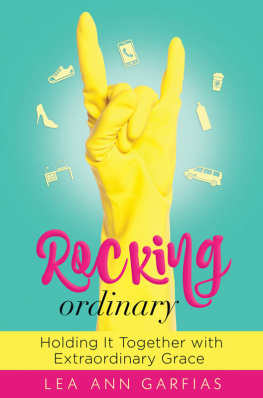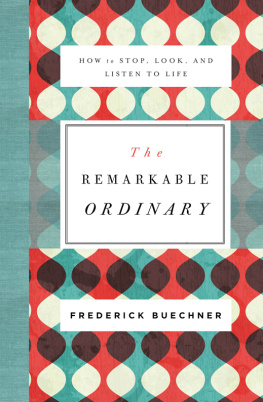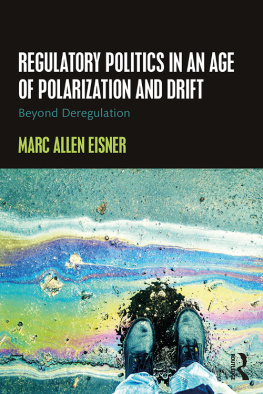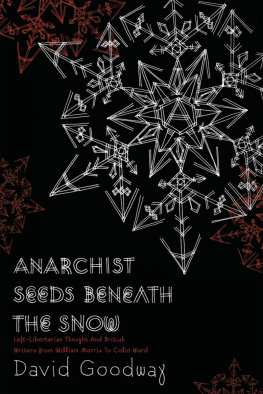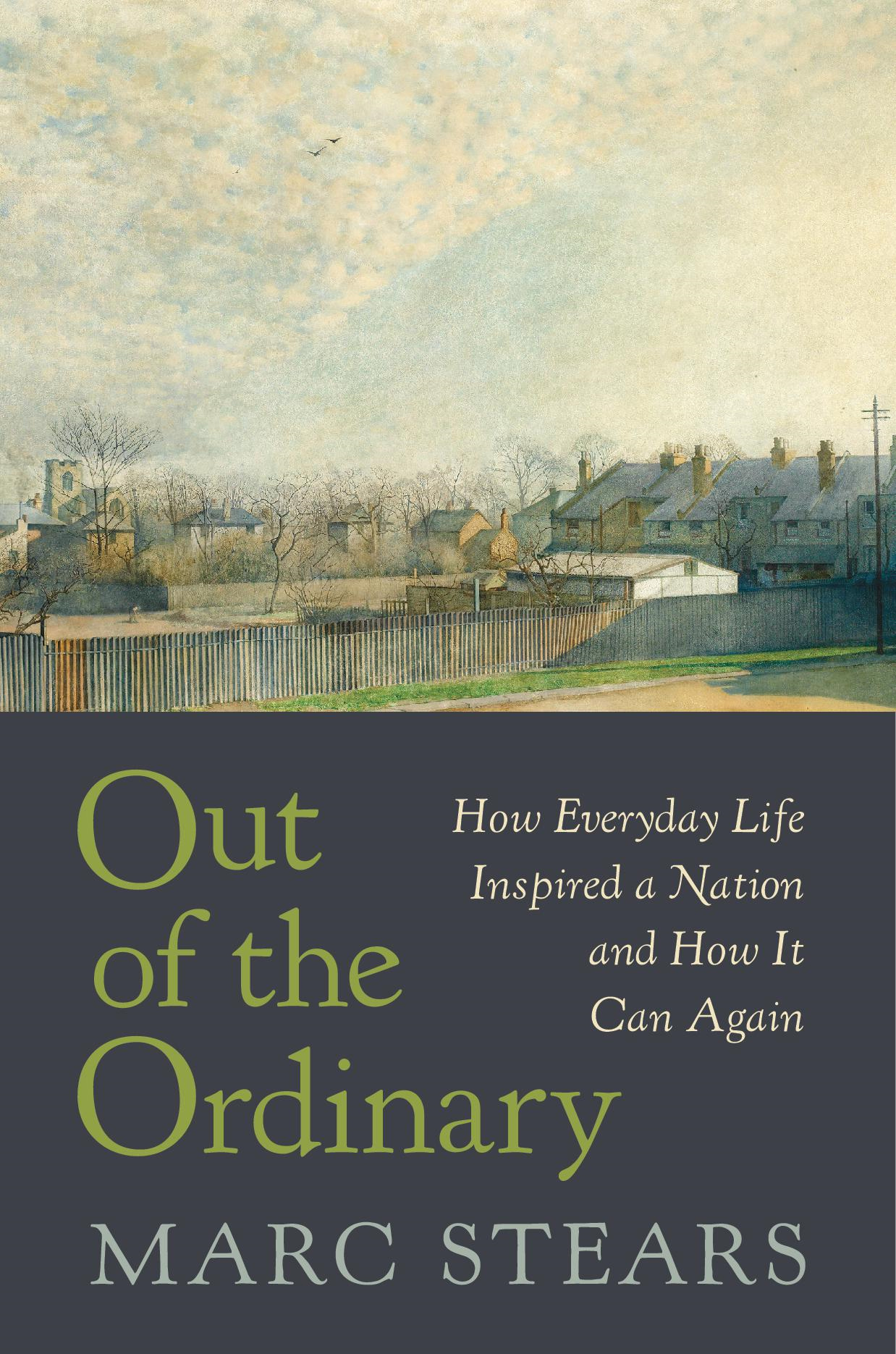Contents
Guide
Pagebreaks of the print version
Out of the Ordinary
How Everyday Life Inspired a Nation and How It Can Again
MARC STEARS
The Belknap Press of Harvard University Press
Cambridge, Massachusetts
London, England
2021
Copyright 2021 by Marc Stears
All rights reserved
Jacket design: Annamarie McMahon Why
Jacket art: Spring Morning, Merton, 1932, Harry Bush (18831957). Private Collection Liss Fine Art/Bridgeman Images
978-0-674-74387-8 (cloth)
978-0-674-25013-0 (EPUB)
978-0-674-25014-7 (MOBI)
978-0-674-25015-4 (PDF)
The Library of Congress has cataloged the printed edition as follows:
Names: Stears, Marc, author.
Title: Out of the ordinary : how everyday life inspired a nation and how it can again / Marc Stears.
Description: Cambridge, Massachusetts : The Belknap Press of Harvard University Press, 2021. | Includes bibliographical references and index.
Identifiers: LCCN 2020021000
Subjects: LCSH: Festival of Britain (1951 : Great Britain) | ArtsGreat Britain20th century. | British literature20th centuryHistory and criticism. | Popular cultureGreat BritainHistory20th century. | NationalismGreat BritainHistory20th century. | Popular culture in literature. | Popular culture in art.
Classification: LCC DA566.4 .S685 2021 | DDC 306.0941/09045dc23
LC record available at https://lccn.loc.gov/2020021000
For Freya
Only a man harrowing clods
In a slow silent walk
With an old horse that stumbles and nods
Half asleep as they stalk.
Only thin smoke without flame
From the heaps of couch-grass:
Yet this will go onward the same
Though Dynasties pass.
Yonder a maid and her wight
Come whispering by:
Wars annals will cloud into night
Ere their story die.
Thomas Hardy, In the Time of the Breaking of Nations
Contents
M Y DAD WAS AN ARTIST, so my childhood was full of pictures. A print of Edvard Munchs Scream, a haunting lady from Amedeo Modigliani, a terrifying Medusa: all of them hung on the walls around my bedroom in the little suburban semidetached house in South Wales in the 1970s. But I remember one picture more clearly than any other. It was a photograph of the dome of Londons St. Pauls Cathedral towering over the firestorms of the Blitz. When I was about five or six, my dad used to show it to me at night and tell me tales of how the British people had stood alone in Europe against the horror of Fascism, remaining determined and committed to each other and eventually prevailing despite all the odds, tales that sprinkled a surprisingly proud patriotism into my usual childhood diet of bohemian counterculture.
At first glance, St. Pauls seems an odd choice as the setting for a bedtime story. I had never visited the cathedral. My parents never showed any intention of visiting it. But somehow with that picture, the great cathedral stood for people like us. Not for Britain in some grand, historic, untouchable sense, like Buckingham Palace, the Mall, or even the Palace of Westminster usually do. But for ordinary people. In those bedtime stories, I heard of the City workers who caught a glimpse of the great dome as they hurried over the bridges that crossed the Thames; of the commuters who saw it as their trains from the new suburbs pulled into the stations; of the people of the East End, many of them relatively recent migrants from horrors elsewhere, who lived with the beauty of the cathedral on their doorstep; of the volunteer firefighters, like my grandfather, who fought back the flames of the Blitz; and of those innocents caught up in the horror, like my dad himself, who had been born in a London hospital as the bombs dropped. Resilient there above the chaos, St. Pauls somehow represented all of themno, all of usat our best: standing together, unified in confident defiance, needing neither guidance nor charity, but capable of acting with strength for a good we hold in common that we cannot serve alone. Is it any wonder that I loved it?
These childhood sensations were no accident. Decades before my dad settled down to share them at my bedside, stories like these, often with St. Pauls at their symbolic core, had been consciously crafted by some of the greatest writers, artists, and cultural critics of the British twentieth century: the photographer Bill Brandt, art critic Barbara Jones, poet Laurie Lee, novelist and social critic George Orwell, novelist and playwright J. B. Priestley, and poet and radio essayist Dylan Thomas chief among them. For around twenty years, from the 1930s to the 1950s, they produced stories, poems, travelogues, magazine articles, photo-essays, wartime propaganda films, and radio plays that, read together or apart, offered a new and distinctive vision of what Britain was and what it could be. And they shared them with anyone who would read, watch, or listen.
At the heart of that vision were combinations of ideals that had rarely been thought of before. Through their prose, poetry, and pictures, they celebrated popular patriotism and tradition but rejected aristocracy, bombast, and flag-waving, what Orwell called the Rule Britannia stuff.
Most of all, they rejected the standing of the busy-body bureaucracy of Whitehall experts and the know-it all opinions of the self-declared academic giants of the age. While cultural luminaries such as F. R. Leavis, Wyndham Lewis, and W. B. Yeats called for a restoration of traditional hierarchies and leading radical intellectuals including W. H. Auden, Stephen Spender, Sidney and Beatrice Webb, and Harold Laski turned to Soviet Communism, Brandt, Jones, Orwell, Priestley, and Thomas placed self-consciously humble, everyday humanity at the very core of their ideal. Theirs was an approach predicated on an entire absence of cynicism or contempt towards ones fellow human beings. There is no greater power, Thomas always insisted, than the power of ordinary humanity itself.
This vision of the extraordinary, redemptive potential of everyday life caught the imagination of generations. In the Depression, novels like Orwells Coming Up for Air and social commentary like Priestleys English Journey gave hope to those seeking to climb out of the economic crisis without giving way to either Communism or Fascism. In wartime, Priestleys radio Postscripts, Brandts photo-essays of London, and Thomass films provided stories of Britishness that always combined toughness and grit, on the one hand, with eccentricity, likeability, and a willingness to accept national failings, on the other. Later still, Thomass radio essays, Joness art, and Lees poetry and prose offered an underpinning to the new peacetime social order, showing how promises for a bold, new future did not require revolutionary destruction but could, in Britain at least, be combined with an affirmation of the best of the past. And finally, the whole effort culminated in the great Festival of Britain of 1951, on which so many of these thinkers and their disciples worked. The festival was a mass, nationwide party of industrial exhibitions, midways, art exhibits, concerts, carnivals and conventions, with more than 1,700 events in twenty-three towns and cities, which trumpeted Britains victory in the war while affirming the role of the everyday people of the country in giving the nation its purpose and its meaning. Other demonstrations here and abroad have shown a countrys art, its industries and its institutions, the festivals official guide put it, but none has tried like this to recreate a peoples personality.







